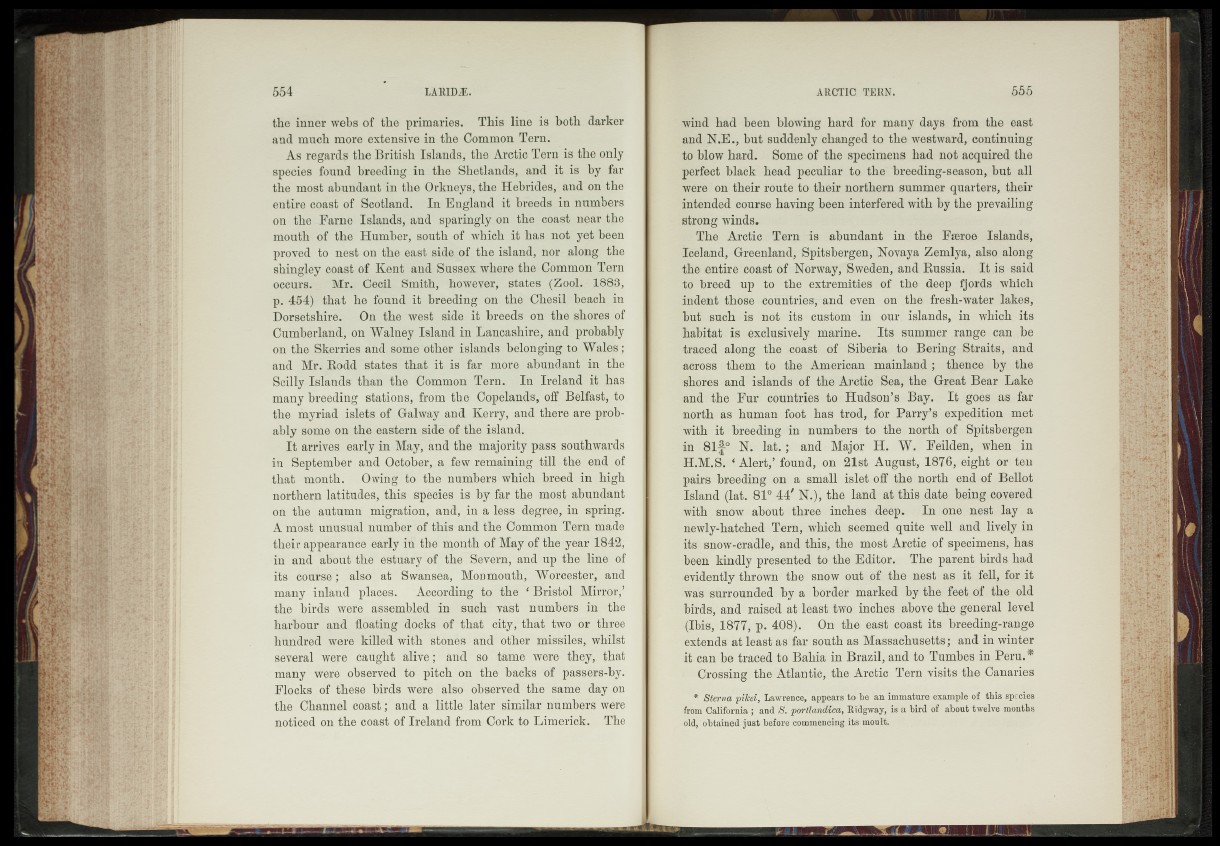
the inner webs of the primaries. This line is both darker
and much more extensive in the Common Tern.
As regards the British Islands, the Arctic Tern is the only
species found breeding in the Shetlands, and it is by far
the most abundant in the Orkneys, the Hebrides, and on the
entire coast of Scotland. In England it breeds , in nupabers
on the Fame Islands, and sparingly on the coast near the
mouth of the Humber, south .of which' it has nob yet .'heen
proved to nest on the east sid^ of the island, nor- along the
shingley coast of Kent and Sussex* where the Common ilejm
occurs. Mr. Cecil Smith, however, states- (Zoo'l. 1883,
p. 454) that he found it breeding on the Qhesil beach in
Dorsetshire. On the west side.it: breeds. on: the shores ^of
Cumberland, on Walney Island in* Ean.cashir^fand probably
on the Skerries and somenther- islandsghelohgi^g:to Wales;
and Mr.- Redd states that. ,j£v-is ,far more - abundant in-; the
Scilly islands than the Common Tern. S§m Ireland it has
many breeding stations, from the- Copelands, off Belfast, $t>
the myriad islets of Galway and Kerry, and there are probably
some on the eastern side "of the^slapd.
It arrives early m May-, and the majority-pass southwards
in September and October, a few remaining til^the end of
that month. .•Owing'to^th'e-mumbers which breed in high
northern latitudes, this ^species- is by far the mpst abundant
on the .^autumn migration, and, in a' less degree, in -spring.
A mWt unusual numbe^^^his and iSre-Common Tern.mads
their appeararice early in-ilfe' month of May of/the^year 1842,
in and about'the estuaryipf the:TS'evetn,' ahd^up the line |)f
it# bourse; also at Swansea, Monugouth, Worbeiter;- and
many inland ^places. Accordibg^ltpu’tbe1 ^'BristolcMirror,’
the birds,,, were ause-mbl'idf in such-wast numbers inl-the
harbopr and floating docks of that' mifyf that; two or thr'oe
hundred wbfe killed with stones *afid other^miSsiles; v^ailst
several were caught ^hvej and so tame -wSre^ tEe^-'that
many were observed' to pitch on the backs 'Of passers-by.
Flocks of- these birds were /also" ’observedHbe same day on
the Channel rcoait; and a little' later' similar numbers#iwere
noticed on the coast of Irelandr-fronu,<£!ork to Limerick.'.' The
wind had been blowing hard for many days from the east
and N.E., but suddenly changed to the westward, continuing
to blow hard. Some of the specimens had not acquired the
perfect black head peculiar to the breeding-season, but all
were on their route to their northern summer quarters, their
intended course having been interfered with by the prevailing
strong winds.
The Arctic Tern is abundant in the Faeroe Islands,
Iceland, Greenland; Spitsbergen,' Novaya Zemlya, also, along
the entire coast of Norway,"Sweden, and Russia. ltd# said
to breed up tb the extremities of the deep fjords which
indent those countriesp and .even on the fresh-water lakes,
‘but such is not its custom,In our, islands, ip- which its
habitat is exclusively marine. Its summer range can be
-traced along it-he .coast; of Siberia^ to Bering Straits, and
across them to the American mainland; thence by the
-shores and islands of the’Arctic Sea, the Great Bear Lake
and. the Fur countries-to-Hudson’s Bay, It. goes as far
north as human.foot - has trod, for- Parry’s expedition met
"with it breeding in numbers-t® the north of Spitsbergen
in 81f%NViat.;; and Major H. W. Feilden, when in
H.^rS^Miert,’. found, on 21st August, 1876,'eight or ten
pairs breeding on . a small islet off the north end of Bejlpt
Island (lat. 81M#ig^); the land- at this date being-cpyered
with snow, about*, three, inches deep. In #h:e. mest lay a
mewly-hatched Tern, which seemed quite-well and lively in
Its snow-cradle, and this, the nstost Arctic of specimens, has
been kindly presented to the Editor- The parent birds had
Evidently thrown the: snowlout of the .nest- as it fell, fqfcit
-was surrounded^ by a border marked ;by the.- feet ©If...the, old
birds, and raised at leastitwo inches above the general level
;(Ibis, 1877, p, 4&8JP On the east coast.its breeding-range
extends at least as far south as Massachusetts;,.and in winter
it can be traced to Bahiai-n Brazil,-and to Tumbes in Peru.*
Crossing the Atlantic, the Tern -visits the ..Canaries
* 'Sterna pifcei, Lawrence, - appears to Re "an immature example of this'Species
:frbm California ; and^SYpoftlUmtiid, Ridgway, is a R ip-of1 about twelve months
old, obtained justf before commencing its moult.